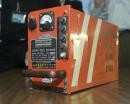Says FAA Needs To Go Back To The Drawing Board
(ANN received a copy of this letter from NBAA Tuesday -- and
we thought you would want to know what it said.
--ed.)
June 28, 2005
Document Management Facility
US Department of Transportation
400 Seventh Street, SW
Nassif Building
Room PL-401
Washington, DC 20590
Re: Docket Number FAA-2005-20245, Revisions to Cockpit Voice
Recorder and Digital Flight Data Recorder Regulations

The National Business Aviation Association (NBAA) represents the
interests of over 7,000 Member companies that own or operate
aircraft to support their business. NBAA also represents nearly 900
companies that conduct operations under FAR Part 135. NBAA submits
these comments in response to the proposed rule that seeks to
revise the regulations for cockpit voice recorders and flight data
recorders.
It is clear from reading the FAA's proposed rule, the regulatory
flexibility analysis and accompanying appendices that the Agency
performed a complete review of the impact of this rule on the
scheduled airline community. If that was the extent of impact of
this Notice of Proposed Rulemaking (NPRM), NBAA would have little
to say.
The proposed regulations included in this NPRM indicate that a
broad segment of both the Part 91 and Part 135 on-demand
communities would have to comply with this proposal; yet there is
no evidence to suggest that the Agency evaluated the effect of this
rule on those communities. NBAA strongly opposes the issuance of a
final rule as it would apply to aircraft operated under Part 91 and
135 on-demand rules without the statutorily mandated initial
regulatory evaluation, regulatory flexibility analysis, trade
impact assessment and unfunded mandates act determination.
Insufficient Data Sampling from Affected Communities
 Section VI.E.3 of the Initial
Regulatory Evaluation, Regulatory Flexibility Analysis, Trade
Impact Assessment, and Unfunded Mandates Act Determination (the
“analysis”) identifies that the FAA sent a survey to
seven aviation industry associations to determine the impact of the
proposed CVR and FDR systems equipment and labor costs. While the
FAA seems to have received information from some CVR vendors about
the costs of upgrading these systems, no data was either solicited
or received from the general aviation community.
Section VI.E.3 of the Initial
Regulatory Evaluation, Regulatory Flexibility Analysis, Trade
Impact Assessment, and Unfunded Mandates Act Determination (the
“analysis”) identifies that the FAA sent a survey to
seven aviation industry associations to determine the impact of the
proposed CVR and FDR systems equipment and labor costs. While the
FAA seems to have received information from some CVR vendors about
the costs of upgrading these systems, no data was either solicited
or received from the general aviation community.
It appears that the FAA did not provide companies that operate
or service general aviation aircraft with an opportunity to submit
relevant cost data on this proposal. The FAA did not include NBAA
in the data survey which would likely have resulted in more data
about the cost to the general aviation community. Historically, FAA
has used NBAA as a resource for obtaining difficult to identify
cost-data for the general aviation industry. It is difficult to
understand why the Agency chose to ignore this segment of the
aviation community during this rulemaking effort. Clearly, this
rule will impose significant costs to businesses and individuals
operating affected aircraft.
Regulatory Analysis
 The FAA issues rules designed to
provide minimum levels of safety. The aviation community must
comply with these rules. Congress passes laws creating rules that
federal agencies must follow as well. 5 USC 603 requires all
federal agencies to conduct an initial regulatory flexibility
analysis. The analysis must describe the impact of the proposed
rule on small entities. The FAA provided the following analysis for
general aviation aircraft: With respect to the economic impact of
the proposed rule on small businesses within these
owners/operators, nearly all of the private operators listed in
Appendix I-2 are corporations.
The FAA issues rules designed to
provide minimum levels of safety. The aviation community must
comply with these rules. Congress passes laws creating rules that
federal agencies must follow as well. 5 USC 603 requires all
federal agencies to conduct an initial regulatory flexibility
analysis. The analysis must describe the impact of the proposed
rule on small entities. The FAA provided the following analysis for
general aviation aircraft: With respect to the economic impact of
the proposed rule on small businesses within these
owners/operators, nearly all of the private operators listed in
Appendix I-2 are corporations.
These entities use their airplanes as an ancillary part of their
primary business (e.g., oil, automotive, computer, etc.), primarily
to transport executives or employees or to deliver parts. As a
result, these operators are distributed across a spectrum of North
American Industry Classification System (NCAIS) codes. However, it
needs to be noted that the average value of these airplanes is
about $20 million and few non-airline small businesses have the
resources to maintain such an expensive piece of equipment that
primarily serves the companies' executives.
Further, if these corporations were to sell their airplanes due
to this rule, commercial passenger airlines and charter air cargo
airlines would provide these ancillary transportation services and
the proposed rule would have minimal impact on these corporations.
Thus, the FAA determined that the proposed rule would not have a
significant impact on a substantial number of small non-airline
entities.
The FAA would not likely accept an "ignorance of the rules"
excuse from a pilot who violated a Federal Aviation Regulation. In
this case, general aviation should not accept a rule from the FAA
because of its ignorance of the industry. The FAA's regulatory
analysis does not contain any mention, notation, or identification
of a single general aviation aircraft subject to this rule.
 We believe that the "information"
contained in the above quoted language bears very little
resemblance of the truth and should be stricken. NBAA urges the FAA
to reopen the docket on the applicability of the proposed rule to
examine –- for the first time -– the impact on Part 91
and Part 135 operations and then to issue a final rule applicable
to this section. NBAA's data identifies over 15,000 aircraft that
were not analyzed by the FAA that could be affected by this rule.
Additionally, NBAA's data indicates that the total cost for the
development of the supplemental type certificate (STC) and
equipment installation could easily reach $70,000 per aircraft. If
each aircraft requires this type of preparation, the total cost of
this rule could exceed $1 billion.
We believe that the "information"
contained in the above quoted language bears very little
resemblance of the truth and should be stricken. NBAA urges the FAA
to reopen the docket on the applicability of the proposed rule to
examine –- for the first time -– the impact on Part 91
and Part 135 operations and then to issue a final rule applicable
to this section. NBAA's data identifies over 15,000 aircraft that
were not analyzed by the FAA that could be affected by this rule.
Additionally, NBAA's data indicates that the total cost for the
development of the supplemental type certificate (STC) and
equipment installation could easily reach $70,000 per aircraft. If
each aircraft requires this type of preparation, the total cost of
this rule could exceed $1 billion.
Many companies that own aircraft subject to this rule are in
fact small businesses that own a single airplane. These aircraft
are not only used, as FAA simplistically states, "to transport
executives or employees or to deliver parts." If questioned by the
FAA, NBAA would have reported that 86% of the passengers on board
these aircraft are not company executives. These aircraft are often
the reason a company will decide to locate its manufacturing plant
in a small town with an airport rather than near a large city.
These aircraft often act as life-saving vehicles, transporting
critically ill or injured people to specialty burn and trauma
centers across the country. These aircraft allow doctors to visit
patients without access to health care in rural parts of our
country.
These aircraft are a vital but often unseen part of our economy
and this regulatory analysis completely discounts their importance
or existence. FAA's conclusion that companies can sell their
airplanes if the cost of compliance is too high violates the
requirements of 5 USC 603. NBAA asks that the FAA truly analyze the
impact of this significant rulemaking on the general aviation
community as required by 5 USC 603 before conducting additional
efforts to finalize this rule.

In summary, NBAA urges the FAA to retract the NPRM as it may
apply to Part 91 and Part 135, to initiate its first statutorily
mandated study on the real impact on general aviation aircraft
operators, to assess that economic impact and issue an appropriate
final rule. Please contact us if we can provide additional
information.
Sincerely,
Lisa Piccione
Senior Vice President
Government Affairs
cc: A. Steinberg, Esq.
N. Sabatini
 ANN's Daily Aero-Linx (04.13.24)
ANN's Daily Aero-Linx (04.13.24) ANN's Daily Aero-Term (04.13.24): Beyond Visual Line Of Sight (BVLOS)
ANN's Daily Aero-Term (04.13.24): Beyond Visual Line Of Sight (BVLOS) Airborne 04.09.24: SnF24!, Piper-DeltaHawk!, Fisher Update, Junkers
Airborne 04.09.24: SnF24!, Piper-DeltaHawk!, Fisher Update, Junkers Aero-News: Quote of the Day (04.14.24)
Aero-News: Quote of the Day (04.14.24) ANN's Daily Aero-Term (04.14.24): Maximum Authorized Altitude
ANN's Daily Aero-Term (04.14.24): Maximum Authorized Altitude







